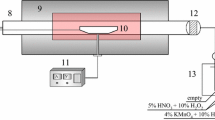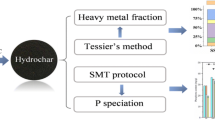Abstract
The effects of sulfur compounds on the migration of a semi-volatile heavy metal (cadmium) during sludge incineration were investigated with two methods, i.e., experiments in a tubular furnace reactor and thermodynamic equilibrium calculations. The representative typical sludge with and without the addition of sulfur compounds was incinerated at 850 °C. The partitioning of Cd among the solid phase (bottom ash) and gas phase (fly ash and flue gas) was quantified. The results indicate that sulfur compounds in the elemental form and a reduced state could stabilize Cd in the form of CdS, aluminosilicate minerals, and polymetallic sulfides, whereas sulfur in the oxidized forms slightly increases Cd volatilization during incineration. For Cd solidification points, the inhibition effect on the volatilization of Cd is as follows: S > Na2SO4 > Na2S. Chemical equilibrium calculations indicate that sulfur binds with Cd and alters Cd speciation at low temperatures (<950 K). Furthermore, SiO2- and Al2O3-containing minerals can function as sorbents stabilizing Cd as condensed phase solids (CdSiO4 and CdAl2O4) according to the results of equilibrium calculations. These findings provide useful information for understanding the partitioning of Cd and thus facilitate the development of strategies to control Cd volatilization during sludge incineration.







Similar content being viewed by others
References
Abanades S, Flamant G, Gagnepain B, Gauthier D (2002) Fate of heavy metals during municipal solid waste incineration. Waste Manage Res 20:55–68
Abanades S, Flamant G, Gauthier D (2003) The kinetics of vaporization of a heavy metal from a fluidized waste by an inverse method. Combust Flame 134:315–326
Asthana A, Falcoz Q, Sessiecq P, Patisson F (2010) Modeling kinetics of Cd, Pb, and Zn vaporization during municipal solid waste bed incineration. Ind Eng Chem Res 49:7605–7609
Chen J, Wey M, Su J, Hsieh S (1998) Two-stage simulation of the major heavy metal species under various incineration conditions. Environ Int 24:451–466
Chen J, Wey M, Liu Z (2001) Adsorption mechanism of heavy metals on sorbents during incineration. J Environ Eng 127:63–69
Chen Y, Zhang YG, Li QH, Zhuo YQ, Chen CH (2008) Effects of sulfur compounds on Cd and Pb partitioning and speciation in a simulated MSW incinerator. J Tsinghua Univ (Sci &Tech) 48:232–235
Cheng H, Zhang Y, Meng A, Li Q (2007) Municipal solid waste fueled power generation in China: a case study of waste-to-energy in Changchun city. Environ Sci Technol 41:7509–7515
Chiang KY, Wang KS, Lin FL, Chu WT (1997) Chloride effects on the speciation and partitioning of heavy metal during the municipal solid waste incineration process. Sci Total Environ 203:129–140
Dai XH, Duan N, Dong B, Dai LL (2013) High-solids anaerobic co-digestion of sewage sludge and food waste in comparison with mono digestions: stability and performance. Waste Manage 33:308–316
Degereji MU, Gubba SR, Ingham DB, Ma L, Pourkashanian M, Williams A, Williamson J (2013) Predicting the slagging potential of co-fired coal with sewage sludge and wood biomass. Fuel 108:550–556
Deng WY, Yan JH, Li XD, Wang F, Cen KF (2008) Pollutants emission characteristics of paper mill sludge drying and combustion system. Ranshao Kexue Yu Jishu 14:545–550
Duan N, Dong B, Wu B, Dai XH (2012) High-solid anaerobic digestion of sewage sludge under mesophilic conditions: feasibility study. Bioresour Technol 104:150–156
Durlak SK, Biswas P, Shi JC (1997) Equilibrium analysis of the affect of temperature moisture and sodium content on heavy metal emissions from municipal solid waste incinerators. J Hazard Mater 56:1–20
Fraissler G, Joller M, Mattenberger H, Brunner T, Obernberger I (2009) Thermodynamic equilibrium calculations concerning the removal of heavy metals from sewage sludge ash by chlorination. Chem Eng Process Process Intensification 48:152–164
Gering KL (1999) Problematic incinerator ash: a case study in finding a successful treatment approach, in: Waste Management 1999 Symposium. Tucson, USA
Han J, Xu MH, Yao H, Masami HF, Takeo S, Hee JK (2008) Influence of calcium chloride on the thermal behavior of heavy and alkali metals in sewage sludge incineration. Waste Manage 28:833–839
Hasan B, Hermann M (2000) Factors determining the element behavior in municipal solid waste incinerators. Environ Sci Technol 34:2501–2506
Ho TC, Lee HT, Chu HW, Hopper JR, Bostick WD (1994) Metal capture by sorbents during fluidized-bed combustion. Fuel Process Technol 39:373–388
Hong JM, Xu CQ, Hong JL, Tan XF, Chen W (2013) Life cycle assessment of sewage sludge co-incineration in a coal-based power station. Waste Manage 33:1843–1852
Jang JG, Kim WH, Kim MR, Chun HS, Lee JK (2001) Prediction of gaseous pollutants and heavy metals during fluidized bed incineration of dye sludge. Korean J Chem Eng 18:506–511
Jiao F, Cheng Y, Zhang L, Yamada N, Sato A, Ninomiya Y (2011) Effects of HCl, SO2 and H2O in flue gas on the condensation behavior of Pb and Cd vapors in the cooling section of municipal solid waste incineration. P Combust Inst 33:2787–2793
Kistler RC, Widmer F, Brunner PH (1987) Behavior of chromium, nickel, copper, zinc, cadmium, mercury, and lead during the pyrolysis of sewage sludge. Environ Sci Technol 21:704–708
Li JX, Yan JH, Chi Y, Ni MJ, Cen KF (2003) Heavy metals emission from a fluidized-bed MSW incinerator. Zhongguo Dianji Gongcheng Xuebao 23:179–183
Li PS, Sun LS, Xiang J, Xiong YH, Hu S, Li M (2006) Solid waste incineration and pyrolysis. China Environmental Science Press, Beijing, pp 112–114
Li QH, Meng AH, Jia JY (2010) Investigation of heavy metal partitioning influenced by flue gas moisture and chlorine content during waste incineration. J Environ Sci (China) 22:760–768
Lin H, Ma XQ (2012) Simulation of co-incineration of sewage sludge with municipal solid waste in a grate furnace incinerator. Waste Manage 32:561–567
Liu JY, Sun SY (2010a) Thermodynamic equilibrium analysis of heavy metals speciation transformation and distribution during sewage sludge incineration. Zhongguo Dianji Gongcheng Xuebao 20:355–365
Liu JY, Sun SY (2010b) Thermodynamic equilibrium analysis of transformation and removal of lead during sludge incineration. Gaodeng Xuexiao Huaxue Xuebao 31:1605–1613
Liu JY, Sun SY, Luo GQ (2012) Thermodynamic equilibrium distribution of Zn, Cu, Ni and Mn during incineration of paper mill sewage sludge. Yingyong Jichu yu Gongcheng Kexue Xuebao 20:200–209
Liu JY, Sun SY, Chen T (2013) Partitioning and transformation of Cd during sewage sludge incineration process. Sci China Ser B Chem 43:94–103
Luan JD, Li RD, Zhang ZH, Li YL, Zhao Y (2013) Influence of chlorine, sulfur and phosphorus on the volatilization behavior of heavy metals during sewage sludge thermal treatment. Waste Manage Res 31:1012–1018
Meng AH, Li QH, Jia JY, Zhang YG (2012) Effect of moisture on partitioning of heavy metals in incineration of municipal solid waste. Chin J Chem Eng 20:1008–1015
Meylan G, Spoerri A (2014) Eco-efficiency assessment of options for metal recovery from incineration residues: a conceptual framework. Waste Manage 34:93–100
Patryk O, Anna Z, Gerard C (2014) Stabilization of sewage sludge by different biochars towards reducing freely dissolved polycyclic aromatic hydrocarbons (PAHs) content. Bioresource Technol 156:139–145
Ran JY, Hu JH, Wang YM, Zhang L, Yan YF (2008) Effects of compounds with metal element and pressure on the combustion characteristics of mixed industrial sludge. Huanjing Kexue Xuebao 28:108–113
Samolada MC, Zabaniotou AA (2014) Comparative assessment of municipal sewage sludge incineration, gasification and pyrolysis for a sustainable sludge-to-energy management in Greece. Waste Manage 34:411–420
Soria J, Gauthier D, Falcoz Q, Flamant G, Mazza G (2013) Local CFD kinetic model of cadmium vaporization during fluid bed incineration of municipal solid waste. J Hazard Mater 248–249:276–284
Tan ZX, Li HB, Wang XL, Jia XG, Yan JH (2007) Species transformation of trace elements and their distribution prediction in dyestuff residue incineration. Chin J Chem Eng 15:268–275
Uberoi M, Shadman F (1991) High-temperature removal of cadmium compounds using solid sorbents. Environ Sci Technol 25:1285–1289
USEPA (1996a) Method 29: determination of metal emissions from stationary sources. Office of Air Quality Planning and Standards, Washington, D.C
USEPA (1996b) Method 5: determination of particulate matter emissions from stationary sources. Office of Air Quality Planning and Standards, Washington, D.C
Verhulst D, Buekens A, Spencer PJ, Eriksson G (1996) Thermodynamic behavior of metal chlorides and sulfates under the conditions of incineration furnaces. Environ Sci Technol 30:50–56
Wang KS, Chiang KY, Tsai CC, Sun CJ (1999) Effect of chlorides on emissions of toxic compounds in waste incineration: study on partitioning characteristics of heavy metal. Chemosphere 38:1833–1849
Wang YM, Hu JH, Ran JL, Zhang L, Pu G, Tang Q (2007) Experimental study on combustion and kinetic characteristics of mixed industrial sludge. Zhongguo Dianji Gongcheng Xuebao 27:44–50
Wey MY, Yu LJ, Jou SI (1998) The influence of heavy metals on the formation of organics and HCl during PVC containing waste. J Hazard Mater 160:259–270
Williams PT (1994) Pollutants from incineration: an overview. In: Hester RE, Harrision RM (eds) Waste incineration and the environment. Royal Society of Chemistry, Cambridge, pp 27–52
Xi YY, Li HJ, Fan WB (2002) Dynamic characteristics analysis on physical and chemical properties of municipal domestic solid waste. Shanghai Huanjing Kexue 21:721–724
Xu ZH, Wang LS (1987) Database of inorganic thermochemistry. Science Press, Beijing, pp 50–74
Yang S, Saffarzadeh A, Shimaoka T, Kawano T (2014) Existence of Cl in municipal solid waste incineration bottom ash and dechlorination effect of thermal treatment. J Hazard Mater 267:214–220
Yao H, Saito N, Mkilaha ISN, Naruse I (2002) Comparative study of lead and cadmium compounds capture by sorbents. J Chem Eng Japan 35:401–408
Zhan TLT, Zhan XJ, Lin WA, Luo XY, Chen YM (2014) Field and laboratory investigation on geotechnical properties of sewage sludge disposed in a pit at Changan landfill, Chengdu, China. Eng Geol 170:24–32
Zhang YG, Chen Y, Meng AH, Li QH, Cheng HF (2008) Experimental and thermodynamic investigation on transfer of cadmium influenced by sulfur and chlorine during municipal solid waste (MSW) incineration. J Hazard Mater 153:309–319
Acknowledgments
The authors gratefully acknowledge the support provided by the National Natural Science Foundation of China (no. 51308132); the Scientific and Technological Planning Project of Guangdong Province (no. 2012B050300023); the Natural Science Foundation of Guangdong Province (S2013040013022); the foundation for distinguished young talents in higher education of Guangdong, China (no. 2012LYM_0055); and the cooperation foundation for industry, university and research institute, Guangdong Province and Ministry of Education (no. 2011B090400161, no. 2011B090400144, no. 2012B090700005).
Author information
Authors and Affiliations
Corresponding author
Additional information
Responsible editor: Angeles Blanco
Rights and permissions
About this article
Cite this article
Liu, JY., Fu, JW., Sun, SY. et al. Effect of different sulfides on cadmium distribution during sludge combustion based on experimental and thermodynamic calculation approaches. Environ Sci Pollut Res 22, 1113–1126 (2015). https://doi.org/10.1007/s11356-014-3368-8
Received:
Accepted:
Published:
Issue Date:
DOI: https://doi.org/10.1007/s11356-014-3368-8




